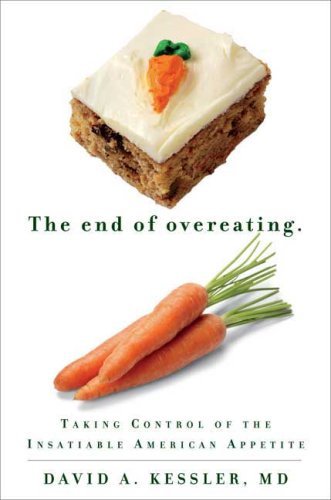
I remember when David Kessler became head of the FDA when I was in middle school. As an MD with a JD, he was a model for combining policy interests with scientific knowledge of health. In my middle school judgement, I found what he said incredibly sensible and just plain smart, and I decided that I should also get an MD/JD so I could grow up to be David Kessler.
Middle school judgements are sometimes exaggerated, but his book The End of Overeating does not disappoint in terms of the breadth of information that it tries to integrate. Kessler combines both human and animal research, frank and sometimes shocking conversations with food consultants revealing the secrets of increasing consumption (e.g., soft drink companies attempting to induce people to drink less water), and a food travelogue to create a compelling story to explain American obesity. For instance, Kessler discusses methods of food manufacture that causes processed restaurant chain food to break down the protein structure of meat and inject marinade so that it can be consumed more quickly than standard meat.
One of his central points is that sugar, salt, and fat combine to make food compelling ("hyperpalatable"), but he treats these elements as if they are interchangeable, but all hyperpalatable foods that he gives as examples have elements with a high glycemic index (breading, sugar, etc.) and the nutrition literature recognizes a distinction between fat and sugar. For instance, rats will overeat on pure sugar, pure fat, and sugar/fat mixtures, but only fat or sugar/fat mixtures increases weight but rats don't gain weight on sugar (one area in which they're clearly different from people --- witness the Snackwells effect which he mentions as well). Rats have few problems discontinuing fat, but discontinuation from sugar causes withdrawal symptoms similar to opioid withdrawal. (Avena NM, Rada P, Hoebel BG. Sugar and fat bingeing have notable differences in addictive-like behavior. J Nutr. 2009 Mar;139(3):623-8. Epub 2009 Jan 28.)
His theory and examples are also disjointed from each other. To bolster his claim that sugar alone is not enough to create hyperpalatability, he describes experiments in which people find skim milk with sugar added unpalatable but really like cream with sugar added, but then he contradicts this theory by describing his own struggles that lead him to eat an entire box of Snackwells fat-free cookies in a short period.
A theory based on macronutrients has extreme limits. While he does talk about flavor with food consultants, he doesn't incorporate flavor into his theory; obviously flavor is complicated. In a few places he says that obviously sugar in the absence of fat isn't a problem because people aren't eating sugar straight out of the bag, not considering that it's not exactly common to see people drinking oil out of the bottle or eating sticks of butter. Flavor is of course the important moderator: people will eat large numbers of meringues, jelly beans, angel food cake, Snackwell cookies, and all sorts of high calorie fat free foods, just as they will eat bacon (and I can't think of any other examples of fatty foods that derive nearly 100% of their calories from fat, to be comparable to jelly beans). An interesting counterpoint would be if he performed experiments in which he tested consumption of food in the absence of flavor, such by wearing noseplugs, as Seth Roberts has experimented with on a small scale.
He makes some strange claims about people historically eating low-fat meat and cites USDA data that people eat more fat than ever before, though other USDA data says that fat consumption has decreased since the 1970s and only sugar consumption has increased.
The book's chapters were short and did not tie together well, so his argument came off as more simplistic and repetitive than if he had written longer chapters that would have necessarily tied his argument together well. Even the short chapters sometimes ended abruptly. For instance, he has a chapter about Cinnabon, the 730 calorie pastry (sidenote: I remember from the only time I had a Cinnabon sometime in middle school that it had 500 calories and being horrified; I decided to check that calorie count again, and in fact now it's 730. Now that 500 calorie cookies are common, Cinnabons had to become 50% larger than before!) He interviews the creator of the Cinnabon and reveals that she had second thoughts about her creation, echoing Cookie Monster's refrain that "cookies are a sometimes food", and that she had created the Cinnabon to be a treat. He adds in a tantalizing last detail that she used to suffer from eating disorders and was unable to distinguish hunger from other needs, but then he ends the chapter abruptly without relating her eating disorder to her second thoughts about having created the Cinnabon.
The chapters about how to resist food are not new and have been covered better elsewhere such as in Brian Wansink's Mindless Eating as well as of course in the literature.
The book does add to the plausible explanations for the rise of obesity in the US, and it's well worth taking an afternoon to read this book. The quotes from food consultants about how to create "irresistible" and multi-layered "eating experiences" ("eatertainment") were especially revealing of the great deal of effort food companies have exerted to produce American obesity.
No comments:
Post a Comment